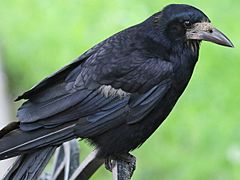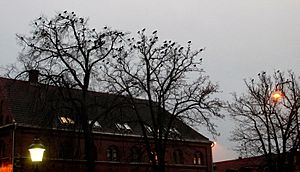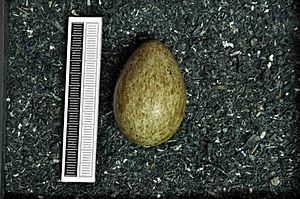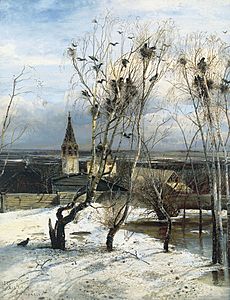Rook (bird) facts for kids
Quick facts for kids Rook |
|
|---|---|
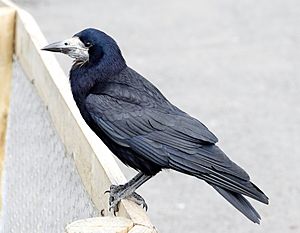 |
|
| Rook in England | |
| Conservation status | |
| Scientific classification | |
| Genus: |
Corvus
|
| Species: |
frugilegus
|
 |
|
| Rook range | |
The rook (Corvus frugilegus) is a type of bird that belongs to the Corvidae family, which also includes crows and jays. You can find rooks across a wide area, from Scandinavia and western Europe all the way to eastern Siberia. These birds are large and have black feathers. They are known for living in groups. One special way to tell a rook apart from similar birds is the whitish, featherless skin on its face. Rooks build their nests together in the tops of tall trees, often near farms or villages. These groups of nests are called rookeries.
Most rooks stay in the same place all year. However, those living in the far north might fly south to avoid very harsh winters. In winter, rooks gather in large groups, sometimes with other types of crows or jackdaws. They return to their nesting sites in spring to breed. Rooks look for food in fields and pastures. They use their strong beaks to dig into the ground, mostly eating grubs and insects found in the soil. They also eat grains and other plants. In the past, farmers sometimes tried to get rid of rooks because they thought the birds damaged crops. Like other birds in the crow family, rooks are very intelligent and can solve simple problems.
Contents
What is a Rook?
The rook was given its scientific name, Corvus frugilegus, by a Swedish scientist named Carl Linnaeus in 1758. The name Corvus means "raven" in Latin, and frugilegus means "fruit-gathering." This name comes from the Latin words for "fruit" and "to pick." The English name "rook" comes from the harsh sound of the bird's call.
There are two main types, or subspecies, of rooks:
- The western rook (C. f. frugilegus) lives from western Europe to southern Russia and parts of northwestern China.
- The eastern rook (C. f. pastinator) lives from central Siberia and northern Mongolia across the rest of Asia.
People have many fun names for groups of rooks, such as a building, parliament, clamour, or storytelling. The way rooks nest together in colonies led to the word rookery.
How to Spot a Rook
Rooks are fairly large birds. An adult rook usually weighs between 280 to 340 g (9.9 to 12.0 oz). They are about 44 to 46 cm (17 to 18 in) long and have a wingspan of 81 to 99 cm (32 to 39 in). Their feathers are black and often look blue or bluish-purple in bright sunlight. The feathers on their head, neck, and shoulders are very thick and smooth. Their legs and feet are black, their beak is grey-black, and their eyes are dark brown.
One key feature that helps you tell an adult rook apart from other crow family members is a bare, whitish patch of skin in front of its eye and around the base of its beak. This patch makes the beak look longer and the head more rounded than it actually is. The feathers around their legs also look shaggier than those of a carrion crow, which is another similar bird. When flying, a rook's wings look longer and narrower than a carrion crow's. Rooks usually live for about six years.
Young rooks look a bit different. Their feathers are black with a slight green shine, but their neck, back, and belly are brownish-black. Young rooks look a lot like young crows because they don't have the bare patch at the base of their beak yet. However, young rooks have thinner beaks and lose their facial feathers after about six months.
-
At the Cafe, Marwell Zoo
-
At Uglich, Russia
Where Rooks Live
Rooks live all year in the British Isles and most of northern and central Europe. Sometimes, they wander to Iceland and parts of Scandinavia. They prefer open farming areas with pasture or arable land, as long as there are tall trees for nesting. They usually stay away from thick forests, swamps, and moorlands. Rooks are generally found in lowlands, with most rookeries below 120 m (400 ft). But if there's good food, they might nest higher, even at 300 m (1,000 ft) or more. Rooks often live near people, nesting close to farms, villages, and small towns, but not usually in big, busy cities.
Rooks also live in Asia. The rooks there are usually a bit smaller and have more feathers on their face. In the northern parts of Asia, rooks tend to fly south in autumn. Rooks from more southern areas might also travel around sometimes.
Some rooks were brought to New Zealand between 1862 and 1874. Now, they are seen as a problem species there and are actively controlled by local groups. This has caused many large rookeries in New Zealand to disappear, and the remaining small groups are much more careful around people.
Rook Behavior and Habits
Rooks are very social birds and are almost always seen in groups. Male and female rooks usually stay together for their whole lives, and these pairs remain within the larger flocks. In the evening, rooks often meet up at their nesting site before flying to a shared sleeping spot. These groups get bigger in autumn as different flocks join together. They gather at dusk before sleeping, often in huge numbers, sometimes with jackdaws. They usually sleep in woodlands or tree plantations. A few rooks might stay at their nesting site all winter, and adult males might sleep together nearby. In the morning, the birds quickly spread out, flying up to 10 km (6 mi) to find food.
Large groups of rooks, whether at nesting colonies or night roosts, can actually change the soil around them because of the amount of bird material they leave behind.
Rooks mostly find food on the ground. They walk or hop around, using their strong beaks to dig into the soil. When they fly to a specific place, their flight is direct, with steady wingbeats and not much gliding. However, when they are just flying for fun near their nesting site, they might glide more. In autumn, large groups of rooks sometimes put on amazing air shows, flying together in synchronized movements, and even doing dives, tumbles, and rolls.
What Rooks Eat
Studies of what rooks eat show that about 60% of their diet comes from plants, and the other part comes from animals. Plant foods include cereals, potatoes, roots, fruits, acorns, berries, and seeds. The animal part of their diet is mostly earthworms and insect larvae, which they find by digging in the ground with their strong beak. They also eat beetles, spiders, millipedes, slugs, snails, small mammals, small birds, their eggs and young, and sometimes even dead animals.
In cities, rooks will eat human food scraps from rubbish dumps and streets, usually early in the morning or at dusk when it's quiet. Like other crow-like birds, rooks sometimes prefer places where there are a lot of people. They can often be seen looking for food in tourist areas or opening garbage bags. Some rooks have even been trained to pick up litter at a theme park in France!
Rook Courtship and Reproduction
The male rook usually starts the courtship, either on the ground or in a tree. He bows several times to the female, with his wings drooping, while making cawing sounds and fanning his tail. The female might respond by crouching down, arching her back, and slightly quivering her wings. Or, she might start the courtship herself by lowering her head and wings and raising her tail. After these displays, the female often acts like she's begging for food, and the male will give her food.
When it's time to mate, other male rooks nearby might try to bother or attack the pair. During these struggles, any male that ends up on top of the female might try to mate with her. She stops these unwanted attempts by leaving the nest and perching nearby. A mated pair of rooks often gently touch each other's beaks. This behavior is sometimes seen in autumn too.
Nesting and Young
Rooks always nest together in colonies, usually at the very tops of large trees. They often use parts of the previous year's nest. In hilly areas, rooks might nest in smaller trees or bushes, and sometimes even on chimneys or church spires. Both the male and female help build the nest. The male usually finds most of the materials, and the female puts them in place. The nest is shaped like a cup and is made of sticks, held together with earth, and lined with grasses, moss, roots, dead leaves, and straw. They break off small branches and twigs from trees, but they also often steal materials from other nests nearby.
Rooks usually lay three to five eggs, but sometimes six or even seven. In Britain, eggs might be laid by the end of March or early April. In colder places like eastern Europe and Russia, it might be early May before all the eggs are laid. The eggs are bluish-green to grayish-green, but they are mostly covered with dark grey and brown spots. On average, the eggs are about 40.0 by 28.3 millimetres (1.57 in × 1.11 in) in size.
The eggs are incubated (kept warm) for 16–18 days, almost entirely by the female. The male brings her food during this time. After the chicks hatch, the male brings food to the nest while the female keeps the young warm. After ten days, the female also starts helping the male bring food, carrying it in a pouch in her throat. The young birds are ready to fledge (fly) by 32 or 33 days old, but their parents continue to feed them for some time after that. Rooks usually have only one group of chicks each year, but sometimes they try to breed in the autumn.
In autumn, the young birds from the summer join together in large groups with rooks that haven't found a mate from previous years, often with jackdaws. This is when you can see the amazing aerial displays performed by the birds. Rooks are monogamous, meaning adults form long-term pairs. Partners often support each other in fights, and a bird might return to its partner after an argument, where they might gently touch beaks, which is a friendly behavior.
Rook Calls
The sound a rook makes is usually described as caw or kaah. It's a bit like the sound a carrion crow makes, but not as harsh. The call can change in pitch and has different versions used in different situations. Rooks make calls both when flying and when perched. When perched, they fan their tail and bow while making each caw. Calls made during flight are usually single sounds, unlike a carrion crow's calls, which are often in groups of three or four.
Other sounds are made around the rookery, like a high-pitched squawk, a "burring" sound, and a half-chirping call. Sometimes, a single rook will "sing" to itself, making strange clicks, wheezes, and sounds that sound a bit like human notes. This song has been described as a deep or throaty version of a starling's varied and sputtering song.
Rook Intelligence
Rooks are very smart birds. While rooks in the wild haven't been seen using tools often, rooks in captivity have shown they can use and understand puzzles. One common puzzle is the Trap-Tube Problem. Rooks learned how to pull their reward out of a tube while avoiding a trap on one side.
In captivity, when faced with problems, rooks have been shown to use tools and even change tools to fit their needs. For example, rooks learned that if they pushed a stone off a ledge into a tube, they would get food. The rooks then figured out they could find a stone and carry it to the tube if there wasn't one there already. They also used sticks and wire, and even learned how to bend a wire into a hook to reach an item. Rooks also understood how water levels work. When given stones and a tube full of water with a reward floating, they understood they needed to use the stones and which stone was best to use.
In one experiment, rooks managed to knock a reward off a platform by rolling a stone down a tube towards the base of the platform. Rooks also seemed to understand that a heavier stone would roll faster and be more likely to knock the platform over. In this same test, rooks showed they understood that they needed to pick a stone with a shape that would roll easily.
Rooks also show they can work together to get a reward. To get a reward, several rooks had to pull strings along the lid of a box to make it move so they could reach the reward. Rooks seem to be equally happy working in a group or by themselves.
They also seem to understand gravity, similar to a six-month-old baby, and even better than chimpanzees in some ways. Even though they don't use tools in the wild, studies have shown that rooks can use them in tests and can sometimes be as good as, or even better than, chimpanzees at solving problems.
Rooks and Humans
For a long time, farmers saw rooks in their fields and thought of them as pests. In the early 1500s, after some bad harvests, King Henry VIII even made a law in 1532 to "destroy Choughs (jackdaws), Crowes and Rokes" to protect grain crops. This law wasn't always followed strictly, but Queen Elizabeth I passed a similar law in 1566 that was taken more seriously, and many birds were killed.
Francis Willughby wrote about rooks in 1678, saying: "These birds are harmful to corn and grain: so that the farmers are forced to use children, with hooting and crackers, and metal rattles, and, finally by throwing of stones, to scare them away." He also mentioned scarecrows "dressed up in a country habit, which the birds taking for countrymen dare not come near the grounds where they stand." It took some time for scientists like John Jenner Weir and Thomas Pennant to realize that rooks actually helped farmers by eating pests in the ground, doing more good than harm.
Rookeries were often seen as annoying in rural Britain. In the past, people would hold "rook shoots" where young rooks, called "branchers," were shot before they could fly. These events were social gatherings and also a way to get food, as "rook and rabbit pie" was considered a special dish. (Adult rooks are not good to eat).
Rooks are found across a very large area and have a huge total population. The main dangers they face are changes in how farmland is used, the use of pesticides, and being hunted. Even though the total number of rooks might be slowly decreasing in some areas, it's not happening fast enough to be a big worry. Because of this, the International Union for the Conservation of Nature has said that the rook is a species of "least concern" for conservation.
Images for kids
-
At the Cafe, Marwell Zoo
-
At Uglich, Russia
See also
 In Spanish: Graja (pájaro) para niños
In Spanish: Graja (pájaro) para niños




